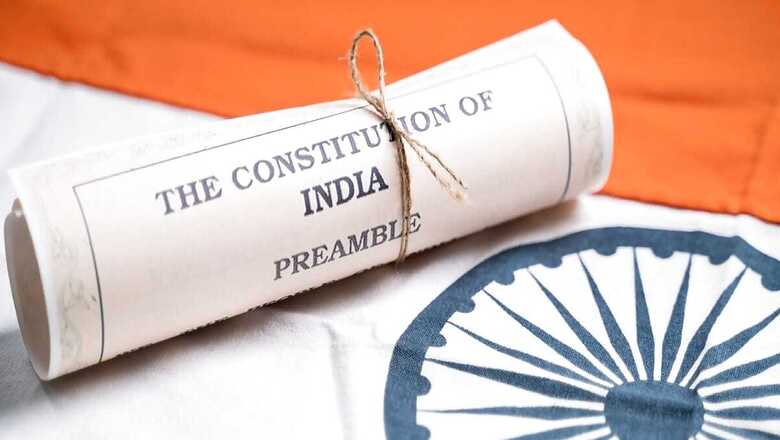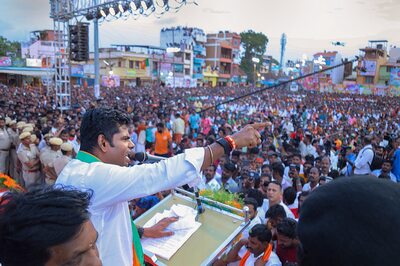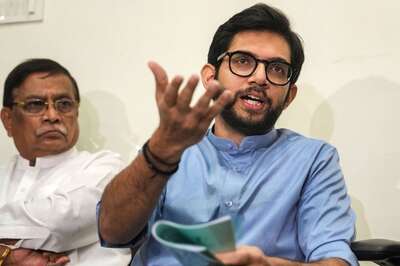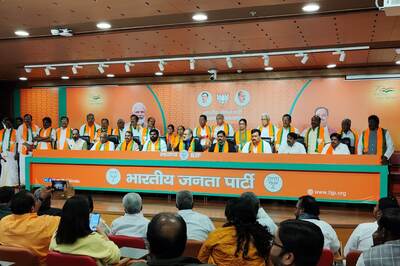
views
The Constitution of India is in the news, but not because it will complete 75 years of its adoption soon. Congress President Mallikarjun Kharge, and the heir apparent of the party, Rahul Gandhi, have both alleged that the Constitution of India is at risk from Narendra Modi. Modi’s re-election, particularly with a 400-plus margin, could spell doom for the Constitution, especially its features like Parliamentary elections and reservation for members of Scheduled Caste/Scheduled Tribe communities etc.
Rahul Gandhi, in his election speeches, is repeatedly vowing to protect the Constitution at any cost. This stance has elicited a response from the BJP. The most laconic one came from BJP President J.P. Nadda, who recently stated that though Rahul Gandhi always carried a copy of the Constitution, he never read it.
Previously Rahul Gandhi had affirmed at Cambridge University on May 25, 2022, that India is not a nation, but a union of states, as the Constitution describes it. He compared the Indian Republic with the European Union- “Think of India that it is politically and economically united, that is what India achieved 70 years ago.” Ironically, it tells more about Rahul Gandhi than either about India or the Indian Constitution. If India is not a nation, then his illustrious predecessors must have erred in naming the party the Indian National Congress. Renaming it as Indian Union Congress is perhaps overdue. The purpose of the Constitution is not to describe the historical or cultural identity of India. It is to lay down a framework for governing the Republic. Article 1 (1) of the Constitution famously states that India, that is Bharat, shall be a Union of States. The verb used in the sentence is shall be and not is unlike what Rahul Gandhi thinks.
The verb shall be is not merely a matter of future tense, but something for a specific purpose only. When, say, an official gazette notifies that somebody has been appointed as the Joint Secretary in the Ministry or general manager of a PSU, it merely states an official fact. It says nothing about his/her station in family or social life because that is not the purpose of an office order. That, however, does not mean that those identities are abrogated. The same is true about the Constitution whose Part I describes “Union and its Territory” – and not the cultural or civilisational identity of India.
Rahul Gandhi seems to be labouring under the mistaken belief that the Constitution nowhere refers to India as a nation. It is most manifestly there in the Preamble which speaks of fraternity assuring the dignity of the individual and the unity and integrity of the nation. The expression “and integrity” (to make the affirmation stronger) was inserted through the Constitution (42nd Amendment) Act, 1976 by his grandmother Indira Gandhi, perhaps because she wanted to make unity more stronger, something Rahul Gandhi is now refuting.
Article 249 establishes the “power of Parliament to legislate with respect to a matter in the State List in the national interest”. How could, without a nation, there would be national interest, in pursuit of which the Constitution allows the Parliament to override conventional boundaries of Union List, State List and Concurrent List subjects mandated under Article 246 and elaborated in the Seventh Schedule of the Constitution? The Directive Principles of State Policy uses expressions like national life, objects of national importance, whereas Fundamental Duties (Article 51A), interpolated by Indira Gandhi through the 42nd Amendment exhort us inter alia “to cherish and follow the noble ideals which inspired our national struggle for freedom”, “to defend the country and render national service when called upon to do so.”
Even while protecting certain draconic laws like MISA (Maintenance of Internal Security Act), Indira Gandhi invoked nationhood. Article 31D, inserted through the 42nd Amendment but abrogated by the Janata government through the 43rd Amendment, spoke of the saving of laws in respect of anti-national activities. To Indira Gandhi, leaders like Jay Prakash Narayan were indulging in “anti-national activities!”
India has a national anthem and a national flag, which must be respected under Article 51A (a). There exists a law called the Prevention of Insults to National Honour Act, 1971 that is again a legacy of Indira Gandhi. Therein lies the story of the deterioration of national sentiment in the grand old party. Indira Gandhi used (or misused) nationalist sentiments in a bid to project herself as an unrivalled leader. The present Congress, which is fighting on the least number of seats (324) since the first general elections, ceased to be at the centre of politics. This explains anti-centricity in its approach, to create a collage of peripheral interests to take on the BJP that has occupied the centre space. Even Rahul Gandhi is increasingly invoking figures like Dr BR Ambedkar and Ram Manohar Lohia rather than Jawaharlal Nehru, Indira Gandhi or Rajiv Gandhi.
II
The Constitution of India has been amended 106 times, affecting many more number of articles and schedules. Nearly every provision of the original Constitution, says Justice Durga Das Basu (1995), has acquired a gloss either from formal amendment or from judicial interpretation, and on working of the Constitution (Introduction to the Constitution of India, 17th Edition, P.393). The idea of amending the Constitution is not an “abomination of desolation”, to borrow that Biblical phrase. Since the Constitution of India goes into minute details in some matters, an amendment might become necessary even to affect a small change. One might find it difficult to believe that one of its articles deals with a mundane subject like grants in lieu of export duty on jute and jute products (Article 273). The Constitution of Japan (1947), a concise document, obviated the need for any change in over 75 years. One of the reasons is that it leaves many things to be determined by statutory laws passed by Parliament.
The Modi government has amended the Constitution merely six times in the last ten years. Some of the subjects of these amendments like land enclave exchange with Bangladesh (100th amendment, 2015), Goods and Services Tax (101st amendment, 2016) or granting women one-third of reservation in Lok Sabha and legislative assemblies (106th amendment, 2023), the Congress could claim as their brainchild.
The majority of the Constitutional amendments actually came during the Congress regimes. Indira Gandhi desired to take Constitutional amendments to a different level altogether. She would brook no limitation imposed by a written constitution, ipso facto, on “Parliamentary superiority”. While speaking during the introduction of the Constitution (24th Amendment) Bill, 1971 in Lok Sabha on July 28, 1971, she said, “A controversy has been generated as regards supremacy of Parliament as against the supremacy of the Constitution, as if these were two distinct concepts mutually exclusive and even perhaps antagonistic. Those who describe the issue in the manner conveniently forget that our Constitution was drafted on the fundamental assumption that our people owed unalterable allegiance to the principles of democracy. This faith in our people permeates our Constitution.”
It was a valid and philosophical statement indeed. However, one needs to read between the lines here. The Bill in question, introduced by Law Minister H.R. Gokhale, pertained to the amendment of Articles 13 and 368. Article 13 stood between the legislative supremacy and citizens’ fundamental rights. Article 13 (2) decrees that the State shall not make any law which takes away or abridges rights conferred by this Part (i.e. Part III titled Fundamental Rights), in so far as they are inconsistent with its provision, shall to be extent of inconsistency, be void. Now, a Constitution amendment is also a law, since it is introduced in Parliament like any other bill, though it requires a greater majority in each House to pass the same (a majority of total membership of the House, and two-thirds of the members present and voting). Should it be allowed to ride roughshod over Fundamental Rights?
Let us understand the historical perspective as well. It was the judgment of Golak Nath v State of Punjab (1967). An eleven-judge bench decided by a majority of 6:5 that though there was no explicit restriction on Article 368 to amend any part of the Constitution, Part III viz. Fundamental Rights should be shielded from this unrestricted authority. The Constitution (24th Amendment) Bill, 1971 was brought to nullify the ruling in the Golak Nath case.
The semantic change in Article 368 is also revealing. Whereas the title in the original Constitution (1949) read, “Procedure for amendment of the Constitution”, it was changed into “Power of Parliament to amend the Constitution and procedure thereof” (in a bid to affirm Parliamentary supremacy). A new passage inserted in the text read- “Notwithstanding anything in this Constitution, Parliament may in exercise of its constituent power amend by way of addition, variation or repeal any provision of this Constitution in accordance with the procedure laid down in this article”.
The use of the term ‘constituent power’ was no less suggestive. Could the Parliament assume the powers of a Constituent Assembly, and rewrite the Constitution, if it so desired? While Indira Gandhi felt yes, the Supreme Court reached a different conclusion. In the Kesavananda Bharati v State of Kerala, which was heard by a 13-judge bench, the path-breaking “basic structure doctrine” was devised. In short, the Supreme Court held that Parliament’s Constitution amending power under Article 368 was not absolute, but subject to implied limitations that the amendments could not abrogate to destroy the foundations on which the Constitution rested.
The basic structure doctrine, says a Supreme Court publication (2016), soon acquired a life of its own. In various subsequent decisions, the court crystallised the basic structure doctrine to include judicial review, democracy, federalism, and secularism. Independence of judiciary, separation of powers between the legislature, executive and judiciary, democracy, free elections and the Rule of law (Courts of India: Past to Present, P.254).
Was Indira Gandhi contented with the verdict of the apex court? Did she respect the verdict of the judiciary, an essential limb of the Constitution? No. As the subsequent developments proved, she was waiting to avenge herself upon the Supreme Court; force it to revisit the basic structure doctrine; and quell people’s Right to Constitutional Remedy under the cover of Emergency.
This is Part I of the two-part series.
The writer is author of the book “The Microphone Men: How Orators Created a Modern India” (2019) and an independent researcher based in New Delhi. Views expressed in the above piece are personal and solely those of the author. They do not necessarily reflect News18’s views.




















Comments
0 comment